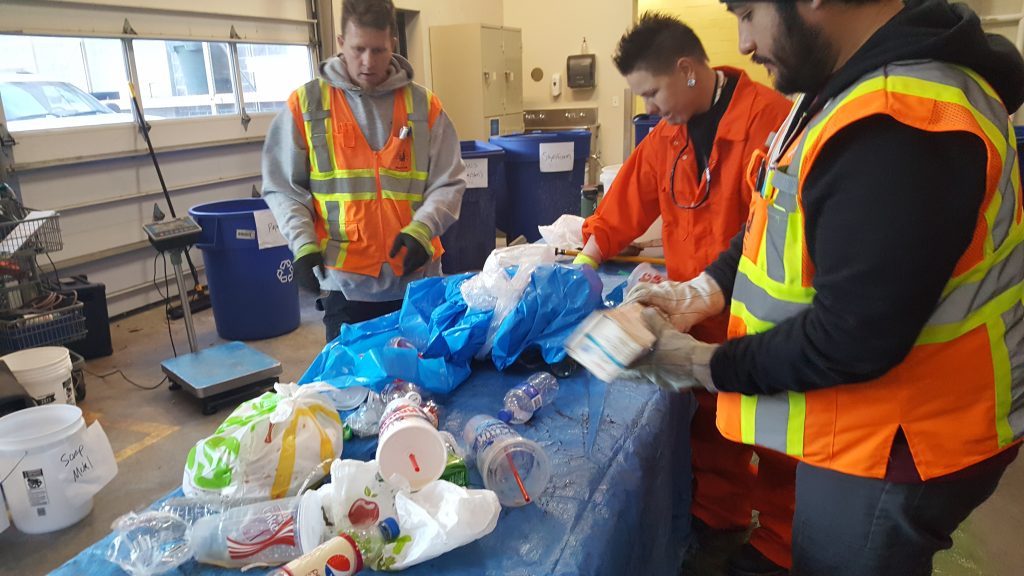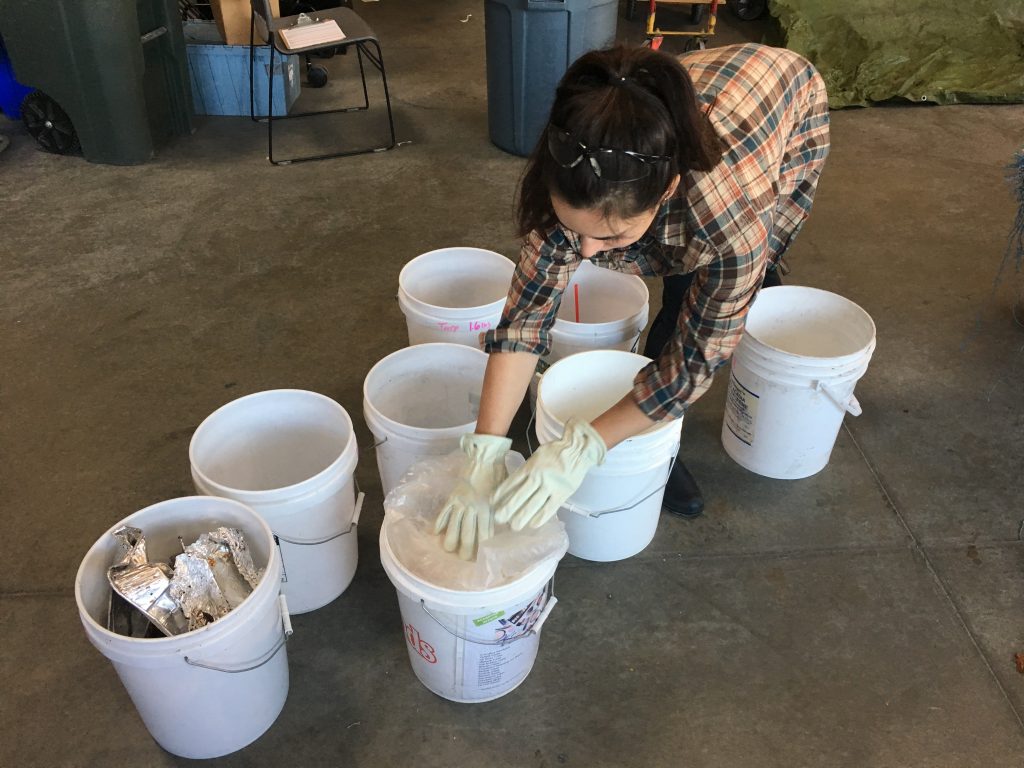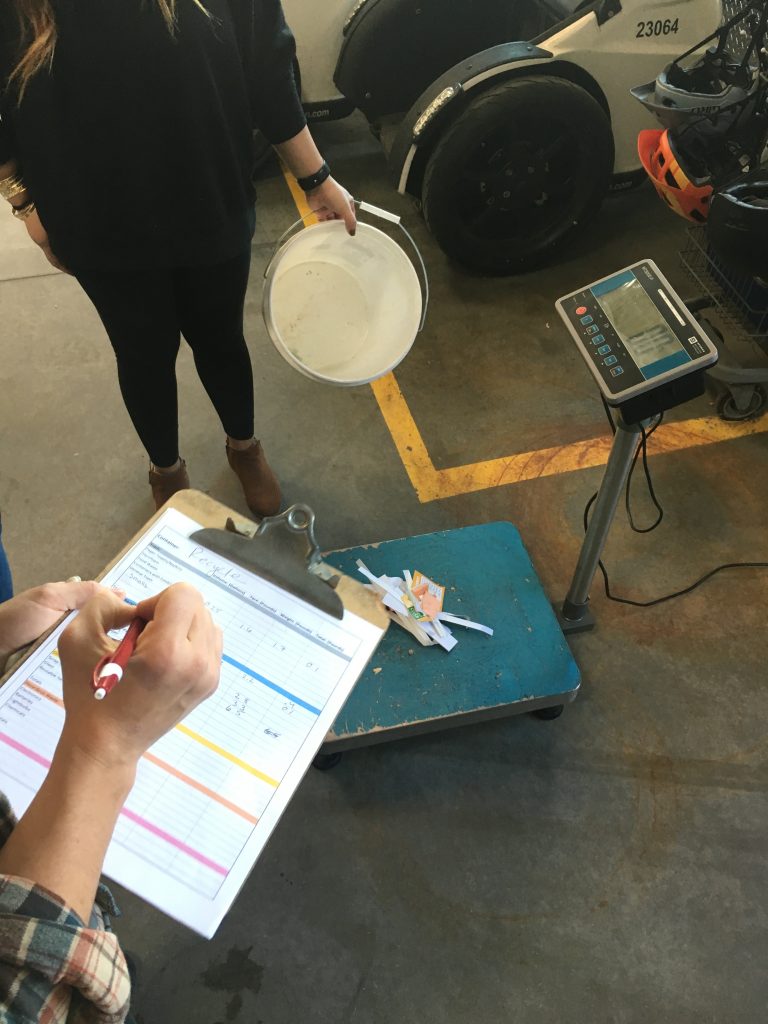Collectively, departments use a significant amount of materials – like office supplies, equipment, and packaging. Think about the lifecycle of those items. A throwaway bottle or ream of paper was mined or harvested; impacted local habitats; and consumed energy in its production. If those items can be avoided or remade into other goods, the negative impacts on the environment are lowered. Not only that, diverting waste through recycling, composting, and reduce/reuse impacts the longevity—and cost—of our landfill. Because of its importance, everyone should help recycle correctly to keep the cyclical system functioning optimally.
What is a Waste Audit?
Waste audits are valuable tools for assessing the waste stream of a department for opportunities to save resources and money. A waste audit is a thorough examination of what type of waste a workplace creates, how much, and whether the proper items are being recycled and landfilled. Undertaking a waste audit is the first step to helping a team improve recycling and avoiding waste. As with other goals, “you can’t manage what you don’t measure.”
There are multiple ways to conduct a waste audit depending on your available resources. We’ve outlined how to do an in-depth waste audit and a simpler “visual” waste audit. If you would like to do an office waste audit, facilitated by the Waste & Recycling Division, email slcgreen@slcgov.com. It’s fun!
The In-Depth Waste Audit
Conducting a waste audit consists of three main steps:
1. Collect and save your workplace’s trash and recycling for a set period of time. This collection period can be flexible to meet the needs of your team. Dump all trash into one larger trash bin and all recycling into another.
- If your workplace produces a lot of trash, feel free to collect for a shorter period of time, such as for one week. For smaller offices, it may be helpful to collect waste for a couple of weeks to better see trends in what sort of materials are thrown away.
- Consider the timing of the audit. Does your workplace produce more waste or different types of waste depending on the time of the year? It can be helpful to plan your waste audit with this timing in mind to see what would be most applicable for your department.
- Do you have space available to sort and weigh your recycling and trash? Consider carrying out this part of the process outside in good weather, or contact the Waste and Recycling Division to borrow their space. If space is unavailable, check out the option of doing a visual waste audit described below.
- Safety: Always use caution when handling waste. Wear gloves and eye protection as necessary. You don’t always know what is being thrown away!
2. Go through the saved contents from the trash and recycling bins to assess the nature and volume of materials placed in each type of bin.
- Once a location for the audit is identified, set up a table with a tarp over it to help keep your area clean. Dump the contents of the collected recycling onto the table and sort the items into categories based on material (ideas for categories are listed below). Weigh each category and estimate each category’s volume. An easy way to estimate volume is by using a container where you already know the volume – like a five gallon bucket – and estimating how full it is.
- After all waste and recycling is sorted and weighed, dispose of it properly.
3. Analyze the data to see trends of contamination (i.e. non-accepted items in the recycling bin), how much waste was diverted from the landfill, and other markers that are relevant for you.
- You can make great visuals for how much of the recycling was contaminated and what materials were disposed of with basic pie charts. Use these in education efforts to your staff. Additionally, your diversion rate from the landfill can be a great marker to share with the community or other departments to show your dedication to resource management!
- If you see items, such as disposable utensils or cups in the bin, this is a great time to educate about the problems that single-use plastics cause and to promote sustainable purchasing.
Use what you learned from the audit to target recycling education to your staff and find opportunities for better purchasing of supplies.
After a period of time (such as a month), conduct a second waste audit to see if your education and changed behaviors improved your diversion rates and conservation. Continue to do waste audits less frequently to continue to track progress. One audit a year can be a great way to gather long term information on trends and opportunities for improvement. This education should be continued as needed to keep people updated on good practices. Don’t forget – you can tailor this to your department’s needs! Add or subtract categories that make sense for your department.
Here’s a checklist of what you need to get started! While everyone’s waste audit may look different, this list can be a good starting point:
- Containers to sort the materials into (It is best if you know the volume of the containers)
- Table or outdoor area
- Tarp or table covering that can get dirty
- Scale
- Gloves
- Clipboard and Pen/Pencil
The Visual Waste Audit
If you do not have the space or capacity to do the in-depth waste audit described above, you can get helpful information from just visually checking waste and recycling bins. Track what you see and estimate how much waste and recycling is produced. This method can be a great starting point for seeing what areas your department needs to focus on for improvement. Make sure to be consistent in your process and take notes for future visual audits.
Check back here soon for a case study of a waste audit that was done with Salt Lake City’s Housing and Neighborhood Development Department!
If you have any questions or would like to have the Waste and Recycling Education Team help guide your audit, reach out to slcgreen@slcgov.com.

Separating Your Materials into Categories
Have one sheet each for the collected trash and for the collected recycling that have the following categories. Here’s an example of what your collection data could look like: Waste Audit Categories – Template.
Other: Any miscellaneous items that come up.
| Trash | Styrofoam, food waste, containers with food or liquid, disposables (disposable utensils, plastic bags, disposable cups, paper towels, napkin, coffee pods, stir sticks, etc.), general trash. |
| Blue Bin Recyclables | Empty plastic containers, aluminum, steel cans, cardboard, single-sided paper, double-sided paper, refrigerated cartons. |
| Other Recyclables | Scrap metal, glass, reusable items. |
| Hazardous Waste | Electronics, batteries, lightbulbs, chemicals. |
| Other | Any miscellaneous items that come up. |


